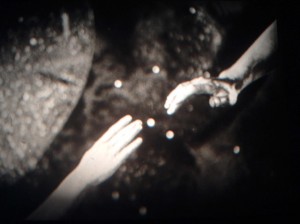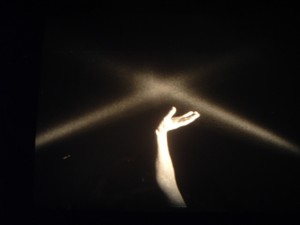Stella F. Simon and Miklos Bandy’s 1927–28 16mm film, Hands: The Life and Love of a Gentle Sex, is a short, experimental, feminist film whose aesthetic is drawn from American and European modernist photography movements and early avant-garde film traditions. The film’s underlying melodramatic narrative formula is complicated by the use of hands as both protagonists and as the central aspect of its modernist mise-en-scène. However, as with so many of the women who collaborated with men in the silent era, official credit did not go to Simon but to Bandy. The titles on all of the extant film prints credit Bandy as the film’s director, but attribute the idea to Simon. When it published four frame enlargements from the film, the British art film journal Close-Up equally attributed the film to him “after an idea by Stella F. Simon.” However, a review published the following month praised “Miss Simon’s” experiment with abstract, constructivist “scenery” (Blakeston 137). This August 1929 article, therefore, becomes the first source in new research that supports Simon as the film’s principle director (Richter 1971, 44; Barr 21; Horak 1995, 43-44; Wild 93-105). Little is known about Bandy, who was the author of one of the first articles in France to discuss Swedish abstract experimentalist Viking Eggeling’s short film Symphonie Diagonale (1924) in Germaine Dulac’s journal, Schémas. Modernist composer Marc Blitzstein wrote and performed the film’s original four-hand mechanical piano score and made a composite recording of it in March 1936 at the behest of RCA and the Museum of Modern Art (Lehrman 35).
Stella Simon, née Furchgott, was born in Charleston, South Carolina, and grew up in Denver, Colorado, where she worked as a darkroom assistant after high school. In 1900, she married Adolphe Simon, with whom she made a home and reared three children in Salt Lake City, Utah. Upon his death in 1917, Simon moved her three boys to San Francisco, where she met the Photo-Secession photographer Anne Brigman, who played an influential role in Simon’s decision to move to New York City to pursue formal photographic training at the Clarence H. White School of Photography between 1923 and 1925. A founding member of Photo-Secession (1902) with Alfred Stieglitz, White was a renowned teacher of photography who developed, following the philosophy of John Dewey, the “project method” that used technical problems and pictorial limitations to instruct his students. Other notable students of White—though not necessarily enrolled at the same time as Simon—include Laura Gilpin, Paul B. Haviland, Dorothea Lange, and Ralph Steiner (a student between 1921 and 1922).
Clarence White’s students, including Simon and the young gallerist Julien Levy, who was a friend of Simon’s son, accompanied White on a study trip to Mexico in 1925. By this time, Simon was the president of the White School Alumni Association and had also developed an interest in filmmaking. In the fall of 1926, Simon enrolled in filmmaking classes at the Technische Hochschule in Berlin, where she also encountered the modernist photographic movements associated with the Bauhaus School and the New Objectivity movement. While in Berlin, at a UFA screening of German experimentalist Hans Richter’s films, Simon introduced herself to the artist and discussed her own filmmaking project with him. Richter later indicated that he may have contributed footage to Simon’s film (Richter 44).
The first important screening of Hands was on February 16, 1929, at Berlin’s Gloria Palast in the context of a Novembergruppe soirée. According to his “Russian Diary,” Alfred H. Barr traveled to Moscow around 1927–1928 with a print of the film, where he showed it to Russian Constructivist artists Aleksander Rodchenko and Varvara Stepanova. Barr notes that Stepanova asked to reproduce frame enlargements from the film in her journal, Kino, but none were apparently ever published (Barr 21). Hands was shown as part of the inaugural screening for Symon Gould’s Film Guild Cinema in New York on February 1, 1929, which prompted the New York Times reviewer to write “Life and Love, a ballet of hands, is devoted to a strange cause. It seeks to employ hands as graceful and plastic units in some sort of cosmic drama that may mean everything or nothing” (20). For at least two series of screenings (April 1, 1936, and June 1, 1939) celebrating the Museum of Modern Art’s newly formed Film Library, Hands was programmed with director F.W. Murnau’s silent feature motion picture Sunrise (1927) under the rubrics “The German Influence” (1936) and “The German-American Film” (1939). Following the New York Times’s reference to “[films] not equipped with sound apparatus” we can assume that Simon’s film was screened on both occasions with Blitzstein’s newly recorded soundtrack (X4).
Perhaps one of the reasons Stella Simon’s contribution to the 1920s American avant-garde film movement has been overlooked is that her reputation was largely as a still photographer. The Pictorial Photographers of America held a one-woman show of Simon’s photographic career at New York City’s Art Center on January 19–31, 1931, about which one reviewer commented, “Whether it is a head or a still-life, Miss Simon has a way of getting the best out of her sitters” (Harris X13). In this year Simon opened a commercial photography studio in New York and helped Julien Levy curate his gallery’s first exhibition on November 2, 1931, a show that was devoted to American photography and where Levy may have screened Simon’s film. Simon continued to experiment with abstract photographic techniques throughout the 1930s. For example, “Landscape and Cityscape” was an “arresting” large-scale photo-mural included in a group exhibit at the Museum of Modern Art in 1932 (Jewell X7).
Stella Simon stands to gain from recent reconsideration of the American avant-garde film movement, which began with the publication of Jan-Christopher Horak’s Lovers of Cinema (43–44), and continues in Jennifer Wild’s essay that re-historicizes Simon’s film as an early instance of modernist-feminist filmmaking practice (93–105). This new look is facilitated by the inclusion of Hands in the comprehensive digital video collection Unseen Cinema, which makes so much experimental and documentary work from the archives available for study. We now realize that along with other photographers such as Paul Strand and Ralph Steiner, Simon is one of the few who made a transition from still to moving photographic work and back again.


